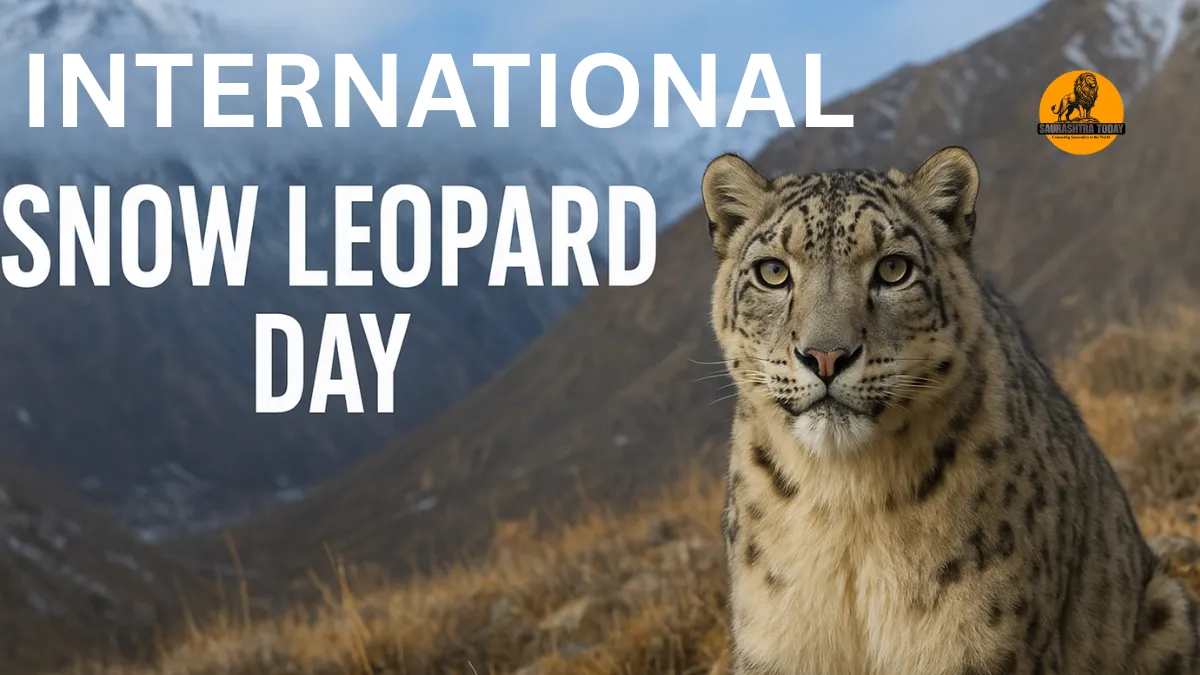A global call to protect one of nature’s most mysterious big cats and the fragile mountain ecosystems it inhabits.
Introduction: The Mystery of the Ghost Cat
High in the icy peaks of Asia, where the air is thin and silence reigns, lives a creature so elusive that even those sharing its territory rarely catch a glimpse. Locals call it the “ghost of the mountains” — the snow leopard.
Every year on October 23, the world celebrates International Snow Leopard Day, a reminder of the urgent need to protect this endangered species and the fragile ecosystems it represents. The observance is not just about saving a beautiful cat; it’s about safeguarding the balance of entire mountain habitats and the millions of people who depend on them.
The Snow Leopard: Nature’s Enigmatic Predator
The snow leopard (Panthera uncia) is one of the most iconic and mysterious big cats in the world. Found in the high-altitude regions of Central and South Asia, its range stretches across 12 countries, including India, Nepal, China, Bhutan, Pakistan, Mongolia, Afghanistan, Russia, Kazakhstan, Kyrgyzstan, Tajikistan, and Uzbekistan.
These cats thrive in cold, mountainous environments — usually between 3,000 and 5,500 meters above sea level. Their thick fur, long tails, and powerful limbs make them perfectly adapted to life in the world’s most rugged terrain. Yet, despite their resilience, they are fighting for survival.
A Species on the Brink
The snow leopard’s population has been under threat for decades. Listed under Appendix I of CITES (Convention on International Trade in Endangered Species) since 1975, and under the Convention on Migratory Species since 1986, the animal is recognized globally as a species in danger.
In 2017, the International Union for Conservation of Nature (IUCN) classified the snow leopard as “Vulnerable” on its Red List of Threatened Species, signaling a high risk of extinction in the wild. Scientists estimate there are only around 4,000 to 6,500 snow leopards left, though accurate numbers are difficult to determine due to their secretive nature.
The Major Threats: From Climate Change to Conflict
Despite living in remote and harsh environments, snow leopards face numerous threats — most of them caused by human activity.
1. Habitat Loss and Fragmentation
As human populations expand into mountainous regions, infrastructure projects, mining, and livestock grazing encroach on snow leopard habitats. This leads to fragmentation of their natural territory, reducing access to prey and safe corridors for movement.
2. Poaching and Illegal Trade
Snow leopards are often hunted for their fur and bones, which are illegally traded in black markets. Their pelts are used for luxury clothing, and bones are sometimes sold for traditional medicine, particularly in parts of Asia.
3. Retaliatory Killings
When snow leopards prey on domestic livestock, herders sometimes kill them in retaliation, viewing them as a threat to their livelihood.
4. Climate Change
Rising global temperatures are melting glaciers and changing vegetation patterns in the high mountains. This not only affects the snow leopard’s prey but also pushes the animal to higher altitudes, further shrinking its range.
International Snow Leopard Day: A Global Commitment
Recognizing these challenges, the United Nations General Assembly in 2024 proclaimed October 23 as International Day of the Snow Leopard. The goal: to strengthen global and regional cooperation for the conservation of snow leopards and their mountain ecosystems.
This international day also emphasizes the importance of biodiversity, urging governments and citizens alike to prevent the extinction of threatened species and restore ecosystems vital for human well-being — including water, climate, and livelihoods.
Why Conservation Matters
1. Ecological Importance
Snow leopards are apex predators — they help maintain balance in the food chain by controlling populations of herbivores like blue sheep and ibex. This keeps vegetation and water sources in balance, supporting entire mountain ecosystems.
2. Water Security
Mountain ecosystems are sometimes called the “water towers of the world.” They supply fresh water to over half of humanity. By conserving the snow leopard’s habitat, we also protect the sources of major rivers such as the Indus, Ganges, and Yangtze.
3. Sustainable Development Goals (SDGs)
Protecting the snow leopard aligns with the UN’s 2030 Agenda for Sustainable Development, including:
- SDG 6: Clean Water and Sanitation
- SDG 13: Climate Action
- SDG 15: Life on Land
Each of these goals is directly linked to preserving biodiversity and combating the climate crisis.
Global and Regional Efforts for Snow Leopard Conservation
Many countries and organizations are working together to secure the snow leopard’s future. These efforts include breeding programs, anti-poaching measures, habitat restoration, and community engagement initiatives.
Here are some of the most notable global and regional programs:
1. Global Snow Leopard and Ecosystem Protection Programme (GSLEP)
Launched in 2013, GSLEP is a collaborative effort among 12 snow leopard range countries. It promotes cross-border conservation, research, and habitat protection.
2. Bishkek Declaration (2017)
Adopted by 12 countries, this declaration titled “Caring for Snow Leopards and Mountains: Our Ecological Future” reaffirmed their commitment to conserve snow leopards and ensure a sustainable future for mountain communities.
3. Samarkand Resolution (2024)
At the 8th Steering Committee Meeting of the GSLEP, member countries adopted the Samarkand Resolution, which focused on climate adaptation, biodiversity preservation, and joint conservation projects.
4. National and Regional Action Plans
- Bhutan (2024–2034): Adopted a climate-integrated landscape approach for snow leopard conservation.
- Nepal (2024–2030): Implemented the Snow Leopard Conservation Action Plan and Ecosystem Management Plan.
- Pakistan: Developed a Snow Leopard and Ecosystem Protection Programme to support local livelihoods and protect habitats.
- Russia: Introduced a Strategy for Snow Leopard Conservation focusing on reducing poaching and increasing research efforts.
- Saudi Arabia: Partnered with Panthera to launch the Arabian Leopard Initiative, which complements snow leopard protection in mountain ecosystems.
5. India’s International Big Cat Alliance
India launched the International Big Cat Alliance (IBCA) — a landmark initiative aimed at protecting all big cat species, including tigers, lions, leopards, jaguars, and snow leopards. Through this program, India promotes knowledge-sharing, research, and technology-driven conservation across Asia and Africa.
Snow Leopard Conservation and Climate Action
Climate change poses one of the biggest long-term threats to snow leopard survival. As mountain temperatures rise, their habitats shrink, and prey availability declines. Conservation strategies now focus on climate resilience — integrating sustainable land management and renewable energy solutions in high-altitude regions.
Programs also engage local communities by providing eco-tourism opportunities, alternative incomes, and livestock insurance schemes, reducing human-wildlife conflict.
Community Involvement: The Heart of Conservation
Experts agree that conservation cannot succeed without the support of local communities. In many snow leopard regions, herders are now becoming “community guardians.”
Through initiatives supported by NGOs like WWF, Snow Leopard Trust, and Panthera, villagers are trained to monitor wildlife, manage grazing, and participate in conservation-friendly tourism. These programs ensure that protecting snow leopards also benefits the people sharing their home range.
Technology in Conservation: From Camera Traps to AI
Modern technology plays a crucial role in tracking these elusive cats. Conservationists use camera traps, drones, and satellite collars to study snow leopard behavior and population dynamics. AI-powered systems are even being used to identify individual leopards from photographs, making data collection more efficient and humane.
Also read: Lion Safari Park Rajkot: Gujarat’s Next Major Wildlife Destination Set to Open by April 2026
A Message of Hope
Despite the challenges, there are reasons to be optimistic. In recent years, sightings of snow leopards in areas like Ladakh (India) and Dolpo (Nepal) have increased, indicating slow but positive recovery. International cooperation, community engagement, and technology-driven conservation are making a difference.
How You Can Help
Even individuals can contribute to snow leopard conservation:
- Support NGOs working in mountain ecosystems.
- Avoid buying animal products made from fur or bones.
- Raise awareness through social media and education.
- Promote eco-tourism that benefits local communities.
Every action, big or small, contributes to preserving this majestic species for future generations.
Conclusion: Protecting the Ghost of the Mountains
As the world marks International Snow Leopard Day, it’s not just about honoring a rare and beautiful animal — it’s a pledge to protect our planet’s fragile mountain ecosystems. The snow leopard symbolizes balance, resilience, and the intricate link between humanity and nature.
If we can save the “ghost of the mountains,” we can preserve the spirit of the wild that sustains us all.


















